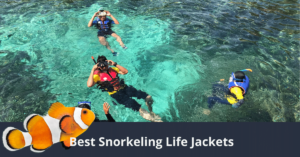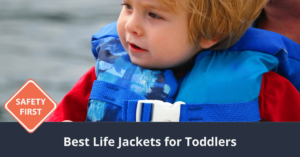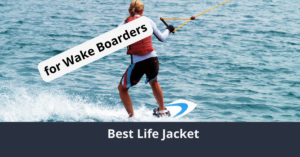Whether you’re a seasoned outdoor enthusiast or you’ve rented a few kayaks here and there (and loved it!), having a kayak life vest of your own is an excellent investment. You know it’s maintained well, and you have one with just the right fit and style for your body type.
Invest in the best kayak life jacket to help you get out on the water and never worry about chafing or discomfort. The personal flotation devices on our list are sturdy, reliable, and, best of all, made for long-lasting wear. Plus, we’ve got the kayak life vest reviews you need, and we’ve answered some burning questions you may have below. Let’s get started!
(If you love to do fishing while kayaking, you should read our article on Best Kayak Fishing Life Jacket)
[Product Table]
Everything you will learn here
The Best Kayak Life Jackets
1. Stohlquist Men’s Trekker
- 500 Denier Cordura shell and 200 denier oxford liner
- Cross-chest cinch harness for zero ride-up
- Ventilated shoulder and back pad.
The Trekker is a Type III life jacket designed for sea level buoyancy of up to 16 pounds. A comfortable ventilate back helps release moisture and keep you cooler while an extra set of side ventilator panels increase airflow all around.
It has an efficient, well-designed chest cinch system to help prevent it from riding up as you paddle and twist. The exterior material is tear-resistant 500 denier Cordura nylon with a 200 denier Oxford nylon lining on the inside. Wash it with soap and hang dry.
The Trekker’s storage options are one of the best features with two front zip pockets for essentials and a back four-way lash accessory system for your other extras. This is an excellent, all-purpose kayaking life vest.
Pros:
- Front storage and back accessory options
- Ultra-durable exterior nylon with comfortable Oxford nylon inside
- Includes large grip tabs on the zippers
- Efficient cinch system to ensure the vest stays put
Cons:
- Front pockets are smaller than average
- Back tends to ride high — adjustments take longer
- Front padding is bulky for short torsos
2. Onyx Movevent Dynamic
- Mesh in lower back fits high back seats;
- Shoulder adjustments with neoprene comfort pads
- SOLAS grade reflective material for visibility
Movevent life jackets are designed to eliminate bulk around the arms, making them good options for fast-paced water. The vest features adjustable neoprene shoulder pads to reduce friction, but the adjustable vest uses only mesh for the sides and lower back.
Front zips and an adjustable belt customize the fit, but the vest is sculpted across the front for a lower profile fit. Zippered pockets and a small lash tab on the back provide storage while 200 denier nylon is soft but tear-resistant.
SOLAS-grade reflective material provides an extra bit of safety, which is useful if you often venture out into rougher waters on your trips. The integrated whistle is always at hand when you need it.
Pros:
- Extra safety features for extreme kayaking trips
- Low profile front padding
- Extra vented mesh lower back and sides for complete movement
- Neoprene prevents friction across the shoulders.
Cons:
- Can be tough to find the right fit
- The high-back style can take getting used to
- The front pocket is small.
3. Eyeson Slim Automatic Inflatable Life Vest
- Lightweight & soft neoprene neckline for all day wearing comfort
For calm waters and all-day wear, Eyeson’s automatic life vest features a slim design with automatic inflation with water contact. It’s CE, and SOLAS certified and offers a cinch system for a customized fit.
The neckline uses softer material so you can wear it all day, even when parked on the bank, and the exterior material is tear-resistant. Wash it with soapy water to maintain it, but other than that, it’s low maintenance.
It offers a universal fit for adults under 330 pounds and a buoyancy of around 33 pounds or 150N. It also provides a manual inflation option as well as automatic, just in case of emergencies.
(You can check our article specially on Best Self Inflating Life Jackets)
Pros:
- A lightweight option for calm water kayaking
- Easily adjust to fit a variety of adult body types.
- Includes both manual and automatic inflation
Cons:
- Requires CO2 cartridges (extra cost)
- Cartridge installation is tricky.
- Coast guard approval pending (European certified)
4. Astral BlueJacket Touring LifeJacket
- MADE FOR SAFETY: Stay afloat with PVC-free Gaia and PE foam inserts; Buoyancy rating of 16.4 lbs; USCG Type III Approval
- INCREDIBLE FIT: Two-panel fit system eliminates ride-up and lets you move freely and get in the zone; Adjustable side release buckle makes it easy to put on and take off; Weighs only 2 lbs
- DURABLE: Made to last for many adventures; 200 x 400 Denier Ripstop Nylon shell and 200 Denier Lightweight Nylon liner; PolyPro webbing and zippers with Self Locking Vislon Teeth
The BlueJacket was designed to take the rigors of ocean kayaking, but the design makes it an excellent all-around option for a variety of kayaking trips. Independent panels help ensure freedom of movement in both rough and calm water.
Clamshell front pockets plus internal zippered pockets give you more than average storage for a life jacket. It also has an inner back sleeve for a water bladder and routing options for both shoulders.
The material is tough with reflective accents and offers a dedicated attachment point for adding in a strobe or other safety light. 400 denier exterior nylon and 200 denier interior nylon create a rip-resistant shell while self-locking teeth keep the vest secure.
Pros:
- Independent exterior and interior panels for better movement
- Includes bladder pocket and two shoulder routes
- Better than average organizational storage
- Intended for sea kayaking
Cons:
- Considerable investment
- No shoulder strap adjustments
- Sizes run large
5. NRS cVest Mesh
- Type III, medium-profile PFD
- 400 denier nylon fabric
- Six adjustment points for customized fit
The cVest Mesh is a lightweight option, but its real appeal is the storage. If you never have enough spots for all your essentials, the cVest gives you six pockets, plus a lash tab, and an extra lanyard loop with a beacon loop on the back.
The front floats are durable, while a mesh back and side panels keep you cooler. It allows proper freedom of movement, and the exterior material is tear-resistant. Larger arm openings could be more suitable for more significant body types.
It includes eight different adjustment points plus SOLAS reflective tape on the front and back to boost safety. The aggressive design is a good option for a variety of kayaking trips.
Pros:
- More than average storage
- Larger arm openings plus a mesh back and side panels
- Bright colors plus safety tape
- Design accommodates higher-backed sea kayaking seats.
Cons:
- The fit may not be suitable for shorter than average adults.
- Strap buckle placement could be ill-placed for some kayak styles.
- A dedicated radio pocket doesn’t fit all radio models.
6. Stohlquist Women’s Flo Life Jacket
- 400 x 200 denier ripstonp shell and 210 denier oxford liner
- Lightweight PE Foam with inner mesh lining for coolness and wearability.
- Neoprene Padded waistband
Stohlquist designed this life vest for the smaller, narrower body proportions of the average female body. It’s designed to fit narrower across the shoulders with more room for the bust and better cinching across the board.
It includes mesh sides and back for freedom of movement and airflow, while the cross-chest cinch harness helps you adjust the fit so that it doesn’t ride up while you’re out. Supportive inner cups for comfort and dual forward pulls across the webbing belt keep things well-fitting.
It uses tear-resistant high-denier nylon that you can clean with soap and water. Its smaller dimensions and molded-front form make it an excellent choice for smaller-framed women because it won’t ride up as much.
Pros:
- Front panel designed for female bodies
- Narrower dimensions
- Mesh sides and back offer freedom of movement
- Easy cinch front mesh
Cons:
- Rescue belt isn’t easy to thread.
- Lash mount is right-handed only.
- Zippers tend to get stuck in piping.
7. Coleman Stearns PFD
- Green with orange highlights
- US Coast Guard-approved
- Comfortable mesh shoulders and back for added ventilation
For a budget alternative that provides excellent safety features, the Coleman Stearns offers many of the same features for less of an investment than average. It uses large armholes and side mesh for a freer fit.
The coast guard approved design offers cinching belts for a customized fit while the 200 denier nylon shell resists rips and tears. It’s a better design for occasional kayak use because the foam tends to ride up in the back.
That said, it’s a solid choice for kayakers who need a secondary vest or aren’t ready to throw down a few hundred dollars on a top of the line, customized vest. With plenty of storage, easily adjustable straps, and coast guard approved design, this life jacket is an excellent first option.
Pros:
- Affordable first vest choice
- Proper storage in the pockets
- Side vents and large armholes for more natural movement
- Solid design choice
Cons:
- The back may not work with high-backed kayaks.
- Sizing runs a little small.
- Slightly bulky
Kayak Life Jacket Buyers Guide – Making sense of it all.
Let’s take a look at the basics of life jackets, their features, and things to look out for when you’re making your decision. All these components work together to build a life jacket that works for you.
Types of Life Vests
Not all life jackets are created equally, and that’s a good thing. These customized designs allow you to find a life vest or personal flotation device that fits exactly the activity you need.
- Type I – Commercial use. It’s designed for flotation even when the wearer is unconscious. It’s designed for open water and rough seas.
- Type II – Standard style life vests designed for near-shore activity and calm water.
- Type III – Intended for water sports near shore, including kayaking, fishing, and skiing. Similar to Type II but designed for better movement.
- Type IV – Throwable personal flotation device, such as the rings you see on television.
- Type V – Designed for specialty cases, such as full-body cold water suits. They may also have a companion number to go along.
Kayak life jackets and personal flotation devices will mostly fall in the Type III category. However, certain specialty options such as cold water gear may also include the Type V distinction. These vests will give you essential protection when rescue is close while maintaining freedom of movement.
Life Vests also have a “performance” distinction, designed to give you more information about how suitable the vest is for the level of swimming and water competence you have.
- Level 50 – For competent swimmers near a shore or with help nearby
- Level 70 – For those with help nearby. They are not designed to keep the wearer afloat in disturbed water if the wearer is unconscious.
- Level 100 – For those swimmers in calm water who aren’t near rescue or a shoreline
- Level 150 – For general purpose use. It doesn’t require any action to keep a swimmer above water and will turn an unconscious wearer to a safe position.
- Level 275 – For offshore use in extreme conditions.
Life Vest Features
These features help you decide what style and model of life vest to use. Consider these things when you’re choosing your life vest.
Entry Method
There are two basic kinds of entry — side and top. Side entry vests often have zips on the lateral sides or the front (hey, it is a side) to allow easy access getting it on and off. Top entry vests require you to loosen straps and put it on like a t-shirt.
How quickly you can get the vest on and off is a matter of preference because you should be wearing the vest the entire time you’re in the water. Both methods are secure and reliable.
Top entries are suitable for people who don’t like fooling with zippers or who prefer to make adjustments based on the bathing suit and kayak they’re using at the time. Side entry could be best for arm and shoulder issues as well as setting the fit and forgetting it.
Outdoor Materials
Personal flotation devices need durable materials that are rip and tear-resistant and preferably have a UV resistance as well. High denier nylon is a good option, along with some poly blend web weaves.
Zippers need to be reinforced with self-locking teeth so that they don’t move out of place. Reinforced seaming along the straps is a must as well to ensure that straps don’t tear as you move.
Molded panels can help with comfort while mesh on the back and sides ensures you have more freedom of movent. The mesh should also be a high denier fabric to ensure it doesn’t tear or snag as you’re moving around.
Common Life Vest Materials
These are the most common types of materials you’ll find on life vests.
Nylon
Most traditional life vests use nylon for the exterior jacket to help prevent rips and tears. Nylon is a capable material that resists environmental conditions. Nylon covers the interior foam, and in some lightweight vests, the material is all nylon mesh for better breathability.
Nylon may be durable, but it does tend to hold water even after you’ve been out for a while. If you’re working in cold conditions, this could contribute to colder body temperatures and dangerous hypothermia.
Neoprene
Neoprene is a newer sports-related material designed to be lightweight and quick-drying. Unfortunately, neoprene isn’t very breathable, so it could cause unnecessary sweat. Manufacturers often use a blend of materials when neoprene is involved to help increase breathability.
Neoprene could be a good option if you aren’t planning to get wet, but you want to be sure you have the right gear on you. This is a good choice as an alternative for a vest material.
Vinyl
Vinyl is extremely durable, but it’s one of the least comfortable materials to use. For a vest that needs freedom of motion, it’s not the best choice. However, engineered vinyl can last for a long time, giving the kayak vest a long lifespan.
Interior Flotation
Flotation methods come in a few different types — naturally buoyant, inflatable, and a hybrid. Most Type III vests are naturally buoyant, giving you a constant float. Inflatables only float when you initiate the vest, either manually or through automatic contact with the water.
Hybrid options offer some extra security with an inflatable option as well as an inherently buoyant material. While this isn’t necessary, if you want an additional peace of mind, you might consider this option.
Storage
You don’t want to weigh yourself down with a lot of gear, but a few pockets could help you keep your essentials with you. Basic vests typically have two zipper pockets, but you can get ones with multiple pockets as well as latch options and carabiner clips.
Look for pockets that can hold the things you care about. If you frequently head into colder waters, warmer pockets could help you keep dexterity for fishing or managing small tasks until the water warms up.
One excellent piece of storage, especially if you tend to be out for long periods, is a water bladder pocket. The bladder pocket makes it so much easier to ensure you have the right liquids. Ensure that you have a route over the shoulder that best suits you.
Storage isn’t the essential part of a life jacket, but it does make wearing one more convenient. You’re more likely to put it on and keep it on if you have the correct details to go with it.
Comfort
One of the worst things you can do is get a vest that doesn’t fit right and is uncomfortable. You’re more likely to take it off because it’s bothering you, and then it won’t serve its purpose. Ensure that it’s a comfortable fit and never compromise on that.
Consider the straps and cinch clips first. These help you get the right fit and prevent the vest from riding up as you’re moving around. The clips also keep the jacket securely where it’s supposed to be.
Padding around the shoulders also helps keep things comfortable. The material inside should be breathable and allow you to stay comfortable even with a wet bathing suit underneath. Kayaking life jackets have larger armholes to allow for better movement and a broader range of motion.
Without these modifications, standard life vests would be very uncomfortable over a long period. You must ensure that you have a kayak, Type III vest, to be comfortable all day.
Buoyancy
Buoyancy is the amount of force you’ll need to keep your head above water. Buoyancy is measured and certified by the coast guard, and all Type III flotation vests must be a minimum of 15.5 pounds of buoyancy. Many jackets will float you between seven to 12 pounds but adhere to these standards to avoid a citation.
Higher buoyancy helps keep you afloat even if you are unconscious, but you must trade that buoyancy for bulk. If you kayak mostly in calm waters, such as on lakes, you can make do on the lesser end of these requirements. If you go out for days on end alone or are traversing rivers and oceans, you may want to up your buoyancy rating.
Durability
All the materials on your vest must be able to stand up not only to rough waters but also sun and wind. Environmental elements can wreak havoc on materials, so the longer you have a vest, the more likely they are to come apart under stress.
It may seem okay to cheap out on certain materials. Still, you’ll want a high denier nylon exterior (minimum 200D) to withstand exterior pressure, and the interior should at least be 200D as well. Also, something like Oxford nylon could give you some extra comfort.
Benefits of Using A Kayak Life Jacket
Life jackets aren’t just a fashion feature. They can keep you safe in nonserious situations and life-threatening ones as well. Water can quickly get out of hand during certain seasons, even if you think they’ll be calm.
If you aren’t familiar with the water you’re in, you can be surprised by sudden rapids. Shallow waters could also be dangerous because if you fall and hit your head, you could quickly be rendered unconscious.
Wearing a life vest keeps your head above water and dramatically increases your chances of survival. If you happen to get swept away in rapid waters or you fall into cold water, you could quickly go into shock. Also, waterlogged clothing could be too much weight to keep you afloat.
Even if you can swim, you can’t account for all the twists and turns of the water. You need to use a safety device while you’re in the water to ensure that you have the best chance of survival in the water no matter what.
Disadvantages
It’s hard to say there are disadvantages to the business of staying alive. Getting a life vest, however, can be difficult if you aren’t a standard body type. The discomfort of having an ill-fitting life vest can cause you not to wear one when you need to.
It can also take some trial and error to find one that fits the way you want, but some of the vests can be quite an investment. Just getting a jacket that has the fit you want may be a long search.
And you must also ensure that it has coast guard certification if you plan to be in any public waterways. The chances of citation are unlikely, but if you ever have to show compliance, this could cause issues.
Using Your Life Jacket The Right Way
These are a few things you need to know about using your life jacket the right way. If you misuse the vest, your vest might malfunction on you just when you need it.
Sizing Your Vest Correctly
Sizing for life vests is based mostly on chest measurements. You’ll need to measure your chest to find where you fall in the size ranges of your chosen model.
Take a cloth tape measure and use it to measure around your chest at the fullest part. If your abdomen is wider than your chest area, this is the place you measure instead of your chest.
Use the inch measurement to find your correct size on the manufacturer’s size chart. If you happen to fall between sizes, you may want to size down to help the vest fit snugly. You’ll probably wear your jacket over a bathing suit or nothing, rather than heavy clothes, so size down for a snug fit.
Panel Size
The panels of the vest can also be tricky if you aren’t a standard body size or type. You want the panels to fit over most of your torso, and not ride up. Finding your right fit might take some trial and error because vests have different cuts.
Fewer adjustments straps are more convenient, but it makes it harder to get a customized fit. When your panel size is right, you need enough straps to ensure that all parts of the vest fit correctly. The vest should be snug without cutting off circulation or digging into your skin.
Maintaining Your Kayak Life Jacket
You’ll need to clean and sanitize your life jacket periodically to get rid of odors and any mold or mildew growth. Luckily, today many life jackets are made of easy-to-clean materials. Here’s what you need to do:
- Hang your life jacket up in a spot with freely circulating air so that it can dry thoroughly every time you use it.
- When it’s time to clean it, rinse it out with a hose or under the faucet of a large sink (or your bathtub).
- Using a mild detergent or dish soap, gently scrub your life jacket. Avoid putting soap directly on the jacket; mix around one ounce of detergent with three gallons of water instead.
- Clean under the straps and in any seaming. Never compress, twist, or flatten the jacket in any way because this could damage the internal structure of the jacket.
- Thoroughly rinse the life vest to remove any lingering traces of soap.
- Hang your life jacket up in a ventilated area out of direct sunlight. Never put your PFD in the dryer or use heat.
The key to cleaning your life jacket is the proper maintenance in the first place. Avoid leaving your life vest crumpled at the bottom of your car or lying on the porch where it’s difficult for the material to dry. Take the time to hang it up and allow it to dry to make it easier when you do clean it.
Safety Tips
Make sure you position your life jacket correctly to help it do its job. While circular personal flotation devices are designed to keep a conscious person’s head out of the water, the front flotation of a kayak life jacket is made to turn you over even if you’re unconscious.
That doesn’t work if you don’t have the right fit. This is how to properly secure a PFD so that you have the best chance in an emergency. The first time you put on a life jacket, run through the following tests:
- Place the PFD over your body and secure it tightly, like tying a shoe. It should fit across your chest and back.
- If you can’t the proper fit using the cinch belts, your vest is too large or too small. Remeasure your chest and choose a vest that falls within your proper fit guidelines.
- Once you have the vest secure, walk into the water up to your chest. Check to see if the vest immediately rides up. If it pushes up over your ears and mouth, it is too big, or you haven’t cinched the straps tight enough.
- If it stays in place, pull your legs up to your chest and allow the device to hold you up. If it successfully floats your weight without active treading, it’s approved.
Drowning happens more quickly than you think. It only takes around 60 seconds for a full-grown adult to drown — that can occur if you’re temporarily rendered unconscious. The majority of drowning accidents happened because the person chose not to wear a life jacket, not because one wasn’t available.
If you’re still unconvinced of the necessity of a good life jacket, our website has an interactive page where you can explore US Drowning Statistics, as well as Worldwide Drowning Statistics and Drowning Prevention.
Take a few minutes to look around and discover why a proper life jacket isn’t just something you keep on board. It’s something you must wear each time you’re in the water. It’s one of the easiest things you can do to keep yourself and those around you safe.
Best Kayak Life Vest Comparison Chart
| Product Name | Price | Available Sizes | Safety | Unique Features |
|---|---|---|---|---|
| Stohlquist Men•s Trekker | $ | SM, M, L, XL, UP | Well-designed chest cinch system to prevent it from riding as you paddle and twist | Ultra-durable exterior nylon |
| Onyx Movevent Dynamic | $-$$ | SM, M, L, Xl, 2XL | SOLAS-grade reflective material provides an extra safety | Extra vented mesh sides for complete movement |
| Eyeson Slim Automatic Inflatable Life Vest | $ | L | Manual and automatic inflation in case of emergencies | Lightweight, Easily adjust to fit a variety of adult body types |
| Astral BlueJacket Touring LifeJacket | $$ | S, M, L, XL | Reflective accents and self-locking teeth keep secure | Bladder pocket and two shoulder routes |
| NRS cVest Mesh | $$ | XS, M, L, XL, XXL | Eight different adjustment points plus SOLAS reflective tape on front and back for safety | Exterior material is tear-resistant |
| Stohlquist Women•s Flo Life Jacket | $ | S, XS, M, L, PU | Dual forward pulls across the webbing belt keep things well-fitting | Tear-resistant high-denier nylon can clean with soap and water |
| Coleman Stearns PFD | $ | L, XL, XXL | Coast guard approved design offers cinching belts for a customized fit | Side vents and large armholes for more natural movement |
Wrap Up
Choosing a life vest or life jacket could save your life. Even if you believe you are a strong swimmer, water can be dangerous without the right conditions. Injury or unconsciousness could prove deadly.
The vests on our list offer you the chance to play safely in the water each time you go out. Plus, you’ll comply with coast guard regulations. Get the right fit and style, and your life jacket could be like part of your body — unnoticed until you need it to survive.
Last update on 2025-04-30 / Affiliate links / Images from Amazon Product Advertising API

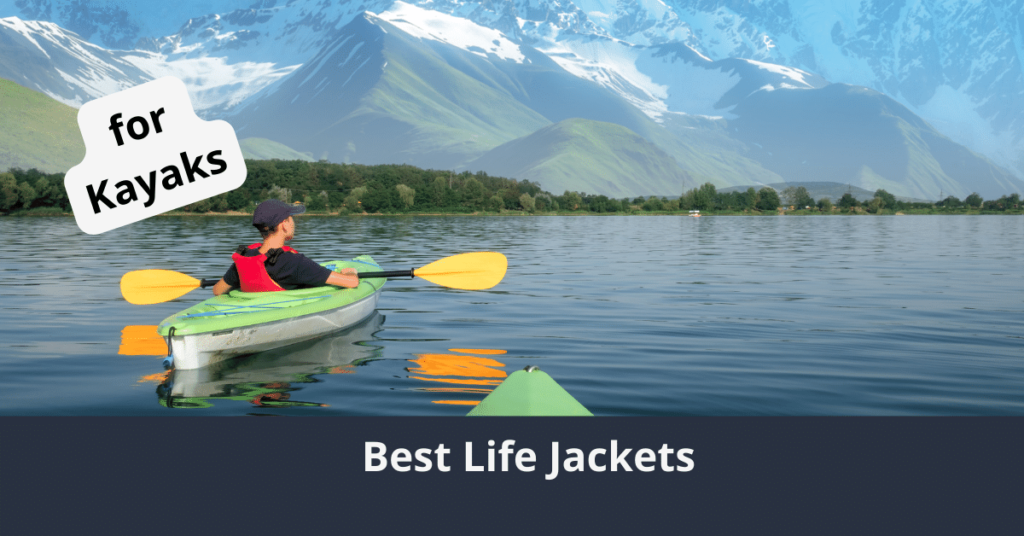





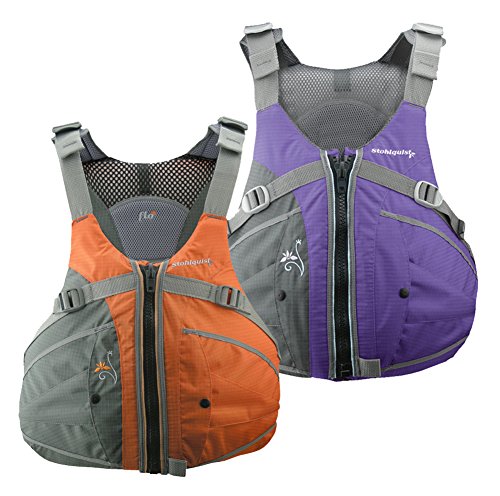

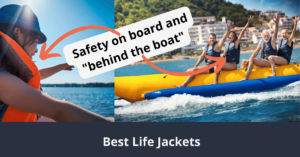
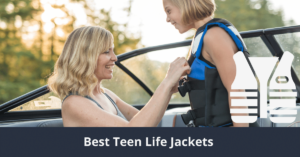
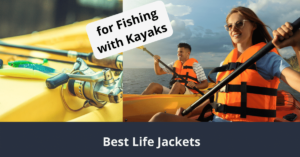
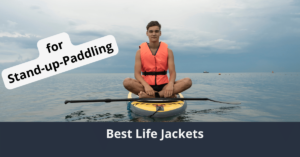
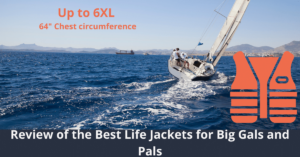



![7 Best Jet Ski Life Jackets with awesome fit [2023 guide] 18 Best Jet Ski Life Jacket](https://insmoothwaters.com/wp-content/uploads/2022/09/Best-Jet-Ski-Life-Jacket-300x157.png)
